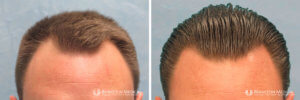
Patient MJE is a 40 y/o Norwood Class 3 with straight, medium weight, dark brown hair, and a donor density of 2.3 hairs/mm2. The after photo was taken three years following two Robotic-FUE sessions totaling 1,354 follicular unit grafts.
Question 1: The main indications of FUE are (select all that apply):
- The ability to wear one’s hair very short on the back and sides after the procedure.
- To maximize donor yield.
- To minimize the cosmetic visibility in the immediate post-op period.
Answer: A. The main advantage of FUE is for the patient to be able to keep his hair short on the back and sides of the scalp after the procedure as the tiny scars from FUE are less visible than a linear FUT scar when the hair is very short. The yield of FUT is generally greater than FUE (see Case 10). In the immediate post-op period, the linear FUT scar is more easily hidden by hair (combed over it) than FUE scars. In FUE, a relatively wide band of hair in the donor area is generally shaved and waiting for this hair to regrow can also delay the return to daily life.
Question 2: What about this patient’s hair characteristics make him a particularly good candidate for FUE (select all that apply)?
- Norwood Class 3.
- Straight hair.
- Hair that is more perpendicular to the scalp.
- Medium weight hair.
- Dark brown hair.
- Donor density 2.3 hairs/mm2.
Answer: A, B, C, D, F. FUE is particularly suited for patients with early hair loss (i.e., NW Class 3’s that have only bitemporal recession, especially in a patient who is older where the progression of their hair loss is more likely to be limited. It is easiest to perform FUE on straight hair that is perpendicular to the scalp as these hair characteristics tend to minimize transection during harvesting. Medium weight or coarse hair is generally easier to extract than fine hair. Hair color has no bearing on the success of the extraction as the hair can be easily dyed to make it more visible (either to the naked eye or the robot). Since the FUE procedure has a lower yield than FUT, it helps to have a higher density when performing FUE (2.2 hairs/mm2 is average).
Question 3: Which is true about the indications for FUE vs Robotic FUE in the treatment of androgenetic alopecia?
- Manual FUE has broader indications than Robotic FUE.
- Robotic FUE is more versatile than manual FUE.
- There are no differences between the two techniques.
Answer: A. The indications for manual FUE and Robotic FUE are almost identical. The only difference is that the robot can only harvest hair from the scalp and not the body or the beard.
Question 4: The main advantage of the robotic system is
- Consistent high-quality extraction.
- The highest graft-yield.
- Fastest harvesting time.
- All the above.
Answer: A. The robot is far more consistent than hand-held devices. That said, with excellent manual technique that remains consistent over the course of the entire procedure, the results of the two techniques will be similar.
Question 5: At the start of 2022 there were several robotic systems available to the physician. These include the:
- Neograft System.
- ARTAS System.
- Trivellini System.
- All the above.
- A and B only.
Answer: B. Although other devices may be falsely marketed as robotic (or automatic) there is only one robotic system available today. It is the ARTAS system manufactured by Venus Concepts.
Question 6: The main excision mechanism of the robotic system is
- An extremely sharp punch with 2 to 4 spikes on it.
- A dull, quickly rotating punch.
- A punch with a slightly splayed distal end.
- All the above.
- A and B only.
- B and C only.
Answer: E. The robot uses a sharp pronged-punch to cut through the first 1-mm of skin and then a dull rotating punch to go deeper into the tissue. The purpose is to first score and stabilize the skin with the sharp punch and to then bluntly dissect the remainder of the follicular unit to avoid damage. This system is unique to the ARTAS robot. A punch with a slightly spayed end is used in some of the newer manual devices.
Question 7: The robotic system is commonly used for:
- Harvesting (extracting) grafts.
- Creating recipient sites.
- Placing (inserting) grafts.
- All the above.
Answer: A. The robotic system is excellent for harvesting grafts, but inferior to manual recipient site creation and graft placement. The robot is used for all three phases of the procedure in less than 10% of practices.
Question 8: A characteristic of the robotic system is that:
- It always requires a tension frame to stretch the skin.
- It can harvest grafts without stretching the skin.
- Either A or B.
Answer: A. The tensioner is an integral part of the robotic system. The tensioner contains fiducials that guide the robotic arm towards its target and the tension on the skin minimizes transection.
Question 9: Which best describes the robotic system?
- Its results are relatively independent of the user.
- It is a relatively complicated system that requires monitoring and adjustment.
- It has been continually modified since its introduction in 2011.
- A and C above.
- B and C above.
Answer: E. Although robotic, the ARTAS system must be programmed for each patient and then adjusted in real-time as the harvesting begins. As harvesting progresses, fewer adjustments need to be made, but continuous monitoring is essential.





